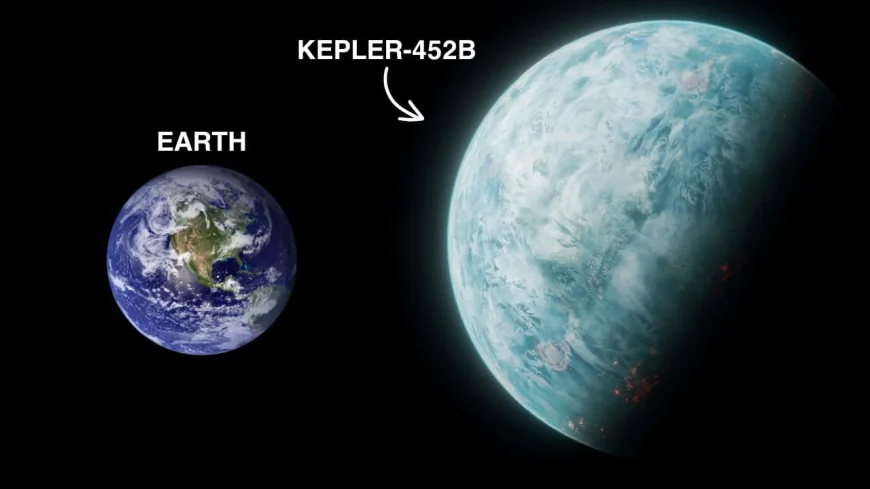Kepler-452b: Earth’s intriguing cousin, a distant world with striking similarities to our own.
Kepler-452b, discovered in 2015, is an Earth-like exoplanet orbiting a Sun-like star in the habitable zone, raising hopes for potential liquid water—and even life. Though its larger size and unknown atmosphere pose challenges, it remains a key focus in the search for worlds beyond our solar system that could one day support humanity.

In the vast expanse of the universe, few discoveries have captured our imagination like Kepler-452b. Dubbed "Earth’s cousin," this exoplanet orbits within the habitable zone of a Sun-like star, raising tantalizing questions about the potential for life beyond our solar system. Discovered by NASA’s Kepler Space Telescope in 2015, Kepler-452b stands out as one of the most Earth-like worlds ever found.
What makes this distant planet so compelling? From its size and orbit to the possibility of liquid water, Kepler-452b presents a fascinating case study in the search for habitable exoplanets. Could it host an atmosphere, oceans, or even life? While we may not have definitive answers yet, exploring Kepler-452b offers a glimpse into the future of space exploration and humanity’s quest to find another Earth.
The Discovery of Kepler-452b
NASA’s Kepler mission was designed to hunt for planets outside our solar system by monitoring the dimming of stars as planets passed in front of them. In July 2015, scientists announced the discovery of Kepler-452b, located about 1,400 light-years away in the constellation Cygnus.
-
Detection Method: Found via the transit method, where a planet’s orbit causes a slight dip in its star’s brightness.
-
Star System: Orbits Kepler-452, a G-type star (similar to our Sun) but 1.5 billion years older.
-
Significance: One of the first near-Earth-sized planets found in the habitable zone of a Sun-like star.
This discovery marked a milestone in exoplanet research, bringing us closer to answering whether Earth-like worlds are common in the galaxy.
Kepler-452b’s Earth-Like Characteristics
Size and Composition
Kepler-452b is about 60% larger than Earth, placing it in the category of a "super-Earth." While its exact composition remains unknown, scientists speculate it could be rocky, with active geology and possibly even volcanoes.
-
Gravity: Estimated to be twice as strong as Earth’s due to its larger mass.
-
Atmosphere: If it has a thick atmosphere, it could trap heat, making surface conditions more extreme.
Orbit and Habitable Zone
The planet takes 385 days to complete an orbit—just 20 days longer than Earth’s year. More importantly, it resides in the "Goldilocks zone," where temperatures could allow liquid water to exist.
-
Star Similarity: Kepler-452 is 10% brighter than our Sun, meaning the planet receives slightly more radiation.
-
Climate Possibilities: If it has oceans, they might still be present, though increased stellar activity could lead to a runaway greenhouse effect.
Could Kepler-452b Support Life?
Potential for Liquid Water
Water is a key ingredient for life as we know it. While we can’t yet confirm if Kepler-452b has oceans, its position in the habitable zone makes it a prime candidate.
-
Atmospheric Retention: A dense atmosphere could help maintain stable temperatures.
-
Tidal Locking Risk: If the planet is tidally locked (one side always facing its star), extreme temperature differences could make life difficult.
Challenges for Habitability
Despite its promising traits, several factors could make Kepler-452b inhospitable:
-
Increased Solar Radiation: Its older, more active star may have stripped away its atmosphere over time.
-
Higher Gravity: Could affect the development of complex life forms.
-
Unknown Atmospheric Composition: Without direct observation, we can’t confirm oxygen or other life-supporting gases.
Future Exploration and Research
Studying Kepler-452b in greater detail will require next-generation telescopes:
-
James Webb Space Telescope (JWST): Could analyze its atmosphere for signs of water vapor or biosignatures.
-
Future Missions: Advanced space observatories may one day capture direct images of the planet.
Until then, astronomers rely on computer models and comparative planetology to hypothesize about its conditions.
Conclusion
Kepler-452b remains one of the most intriguing exoplanets discovered to date. While its Earth-like qualities spark excitement, many mysteries still surround its true nature. As technology advances, we may soon uncover whether this distant world harbors the ingredients for life—or if it’s a cautionary tale of a planet that once resembled Earth but evolved differently.
What do you think—could Kepler-452b be a future home for humanity, or is it jus















































